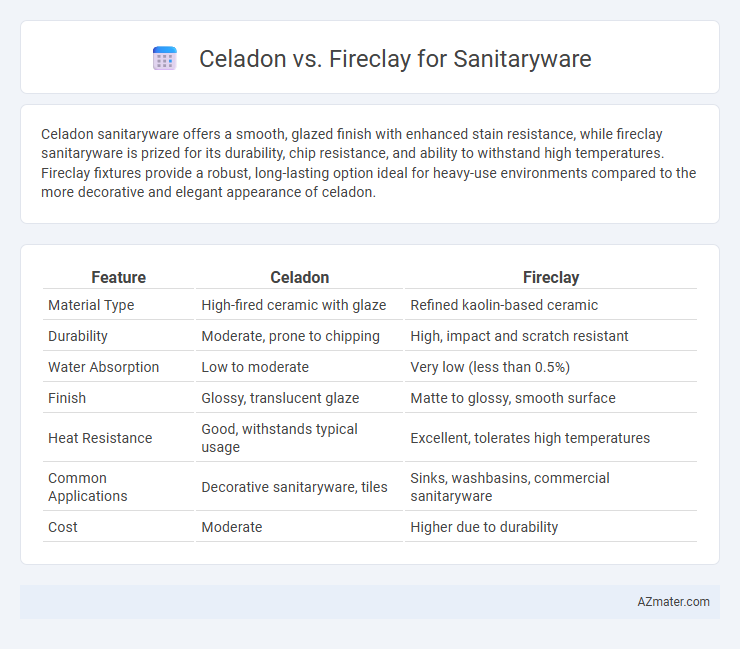Celadon sanitaryware offers a smooth, glazed finish with enhanced stain resistance, while fireclay sanitaryware is prized for its durability, chip resistance, and ability to withstand high temperatures. Fireclay fixtures provide a robust, long-lasting option ideal for heavy-use environments compared to the more decorative and elegant appearance of celadon.
Table of Comparison
| Feature | Celadon | Fireclay |
|---|---|---|
| Material Type | High-fired ceramic with glaze | Refined kaolin-based ceramic |
| Durability | Moderate, prone to chipping | High, impact and scratch resistant |
| Water Absorption | Low to moderate | Very low (less than 0.5%) |
| Finish | Glossy, translucent glaze | Matte to glossy, smooth surface |
| Heat Resistance | Good, withstands typical usage | Excellent, tolerates high temperatures |
| Common Applications | Decorative sanitaryware, tiles | Sinks, washbasins, commercial sanitaryware |
| Cost | Moderate | Higher due to durability |
Introduction: Celadon vs Fireclay for Sanitaryware
Celadon and fireclay sanitaryware differentiate primarily in material composition and finish quality, each offering unique durability and aesthetic benefits. Celadon products are glazed ceramics known for their smooth texture and subtle color variations, while fireclay items are crafted from a mixture of refined clay, fired at high temperatures to enhance strength and chip resistance. Choosing between celadon and fireclay involves weighing factors like longevity, maintenance, and design preference for bathroom fixtures.
Material Composition and Properties
Celadon sanitaryware is primarily composed of high-quality porcelain clay combined with feldspar and silica, resulting in a dense, non-porous surface with excellent durability and a smooth finish. Fireclay sanitaryware is made from refined fireclay mixed with kaolin and fluxing agents, which creates a highly heat-resistant, robust material characterized by its superior strength and resistance to chipping and chemical corrosion. Both materials offer long-lasting performance, but celadon features enhanced surface smoothness and aesthetic appeal, while fireclay excels in toughness and thermal stability for heavy-duty applications.
Manufacturing Processes Compared
Celadon sanitaryware is typically produced using advanced slip casting techniques combined with high-temperature firing that enhance density and durability. Fireclay sanitaryware manufacturing involves firing natural clay with added feldspar and silica at ultra-high temperatures, creating a denser, more vitrified surface with superior resistance to chipping. The precise control of kiln atmosphere and temperature in fireclay production results in a harder, more impermeable finish compared to the relatively porous but lightweight celadon process.
Durability and Longevity
Celadon sanitaryware is known for its high durability due to its dense, vitrified porcelain composition, making it resistant to scratches and stains over time. Fireclay sanitaryware, crafted from a mixture of clay and minerals fired at extremely high temperatures, offers superior longevity with exceptional strength and resistance to chipping and cracking. Both materials provide long-lasting performance, but Fireclay generally excels in robustness and retaining its finish under heavy use conditions.
Water and Stain Resistance
Celadon sanitaryware offers superior water resistance due to its dense and non-porous glaze, which effectively prevents water absorption and reduces the risk of staining over time. Fireclay, while durable and resistant to heat, tends to be more porous, making it relatively less effective at resisting water and prone to staining if not properly sealed. For environments requiring maximum water and stain resistance, celadon is the preferable choice due to its enhanced protective glaze technology.
Aesthetic Appeal and Color Variations
Celadon sanitaryware is renowned for its smooth, translucent glaze that enhances its soft, muted green and blue tones, creating an elegant and tranquil bathroom aesthetic. Fireclay offers a more versatile range of colors with its durable, opaque finish, enabling vibrant and diverse design options that suit both traditional and contemporary styles. Both materials provide unique aesthetic appeal, with Celadon emphasizing subtlety and sophistication, while Fireclay excels in bold color customization and durability.
Maintenance and Cleaning Requirements
Celadon sanitaryware features a smooth, vitrified glaze that resists stains and requires minimal maintenance compared to Fireclay, which is more porous and sensitive to harsh chemicals, leading to potential surface etching over time. Fireclay demands gentle, non-abrasive cleaners and regular sealing to maintain its finish, whereas Celadon can be cleaned effectively with standard bathroom cleaning products without risk of damage. The durability and ease of cleaning of Celadon make it a preferred choice for high-traffic or commercial bathrooms requiring low upkeep.
Environmental Impact and Sustainability
Celadon sanitaryware uses advanced manufacturing techniques that reduce water consumption and minimize waste, contributing to a lower environmental footprint compared to traditional materials. Fireclay, made from fine, natural clay fired at high temperatures, is highly durable and non-porous, which increases longevity and reduces the need for replacements, supporting sustainable usage. Both materials are recyclable, but Celadon's energy-efficient production methods often result in a smaller carbon footprint, making it a more eco-friendly choice for sustainable sanitaryware.
Cost Considerations and Value
Celadon sanitaryware typically offers a lower upfront cost compared to Fireclay, making it an economical choice for budget-sensitive projects. Fireclay, known for its durability and resistance to chipping, provides long-term value by reducing replacement and maintenance expenses over time. Investing in Fireclay fixtures often results in greater cost-efficiency through enhanced longevity and sustained aesthetic appeal, despite a higher initial price point.
Best Applications and Recommendations
Celadon sanitaryware, known for its smooth texture and vibrant glaze, is ideal for residential bathrooms and light commercial spaces where aesthetics and easy maintenance are priorities. Fireclay, offering superior durability and resistance to scratches and stains, suits high-traffic commercial environments such as hotels and public restrooms requiring long-lasting performance. For optimal results, select Celadon for decorative fixtures and Fireclay for robust, functional sanitaryware demanding heavy use.

Infographic: Celadon vs Fireclay for Sanitaryware
 azmater.com
azmater.com